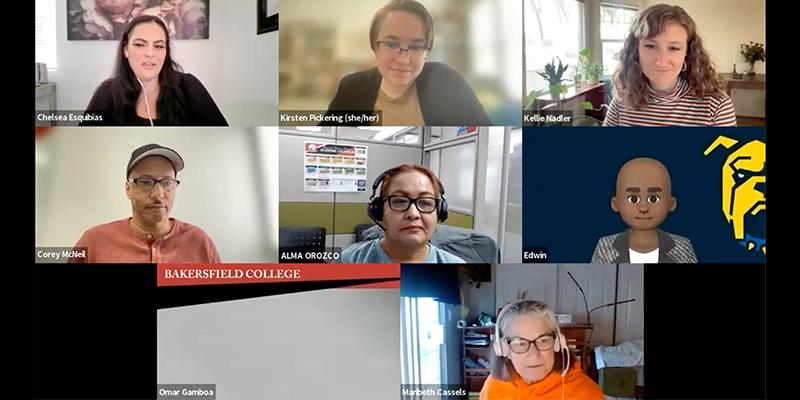San Quentin is the state’s oldest prison, and it is also the only one that still provides free college-level education to inmates. UC Berkeley graduate student Robert Rogers takes us inside the prison gates to explore the impact of the Prison University Project.
ROBERT ROGERS: Lt. Sam Robinson is San Quentin’s public information officer and a former guard at the prison. As he walks down the dim corridors of California’s oldest prison, the rusty metals and peeling paints convey a sense of time standing still.
LT. SAM ROBINSON: This is prison, as it has run here for decades.
But a short walk away, across a courtyard from the stifling cell blocks, there’s something else. It’s a college classroom with an instructor leading a discussion between students who are also San Quentin inmates.
Karen Martin is one of the dozens of volunteer teachers who comprise the backbone of the Prison University Project.
KAREN MARTIN [speaking to class]: The in-group out-group thing is whatever you are, people who are like you are in your in-group. But it could be on any given thing, it could be race, it could be class, it could be education …
The project is a private, nonprofit education program that offers about 300 inmates the opportunity to earn an associate of arts degree. The program was launched in the mid-’90s, soon after Congress voted to axe federal funding to higher education in prisons across the country. Today, the university project in San Quentin is the only accredited, free-of-charge higher education program behind California prison walls.
Executive director Jody Lewen says the program is more vital now than ever.
JODY LEWEN: The demand for education is just going through the roof. We get about, between five and ten letters a day from prisoners at other institutions in the state who are trying to get to San Quentin cause they’ve heard about our program. We have guys who are trying to sneak into our college prep classes because there’s nowhere else to learn.
Lewen, the project’s founder and executive director, is one of three paid employees of the nonprofit, which has an annual budget of around $400,000. Like most of her volunteers, Lewen is long on idealism.
LEWEN: There was no way not to go to college where I grew up. The vast majority of people in this institution, probably in this system, if they had gone to my little private school, never would have seen the inside of this place, no question.
Inmates at San Quentin may choose from a range of classes, from ethics and English to math and natural science.
Four students graduated with an associates degree in June, during a poignant ceremony in a prison worship hall. Prison officials and students’ families attended the ceremony.
GRADUATING STUDENT: Mom, this is for you as much as it for me.
Troy Williams is one of the success stories pointed to by prison officials. A hulking 42-year-old from Los Angeles, Williams is serving a life sentence for robbery and kidnapping.
After about two years in the program, the upbeat Williams is optimistic about earning a degree and, someday, rejoining society. He says education is a positive influence among prisoners.
WILLIAMS: When you come here and you have people who are able to be challenged intellectually and meet those challenges, they think of different ways to resolve problems, as opposed to the lowest level – physical violence. A lot of times what you will see around here is when stuff happens people will go to their mental toolbox as opposed to their physical toolbox.
One of Williams’ English teachers is Kelly Jane Rosenblatt, a 31-year-old PhD candidate and volunteer.
KELLY JANE ROSENBLATT: My father was incarcerated, and I realized when I was corresponding with him that there’s not a lot of opportunities in prison, and that’s when I first learned about this program.
Rosenblatt said failures in childhood education contribute to the state’s prison crisis.
ROSENBLATT: I used to teach middle school in East Oakland, at the lowest-performing middle school in Oakland, and I lost a lot of students over the course of two years. I come in here and I don’t see inmates, I constantly refer to them as students; I caught myself earlier talking about their dorms.
The wait list for classes at San Quentin’s University Project is long, with a hundred on the list. And it’s likely to get longer.
LEWEN: What’s wrong with this picture, how is it that people don’t understand what’s going on here?
Lewen hopes to see steady growth in the program, which relies entirely on private donations, but says a down economy might put a damper on the contributions.
LEWEN: We run the entire campus on less than a half-a-million dollars a year, we have almost 300 students. You’d think that’s an unbelievable bargain, but you talk to most higher education funders they say, ‘oh well, we don’t do criminal justice.’
While the state looks for further budget cuts in its corrections system, the university project is likely to remain the only program of its kind serving the state’s 30 plus prisons and 160,000 inmates.
This report was produced as part of the News21 program, a public service reporting project conducted at UC Berkeley’s Graduate School of Journalism and sponsored by the Carnegie Corporation of New York and the John S. and James L. Knight Foundation.
Attribution: This article originally appeared in SF Gate on July 26, 2010. Read Story
Please note that the Prison University Project became Mount Tamalpais College in September 2020.











